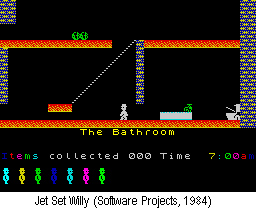|

By Lloyd Mangram
May
1984
Issue 4
|
|
Still
relying principally on the dynamics of a large, powerful
face for a cover image, Oliver turned his attention
to the adventure market. He'd done many illustrations
for books dealing with mystery and horror subjects,
and since so many adventures featured evil wizards and
sorcerers, the character on this cover sprang easily
enough to mind. Discussion, however, revealed that Oliver
was unhappy with the finished picture because it didn't
seem to have any computer relevance. Roger suggested
adding the 'what now' cursor to the eye and the visual
gag was complete.
|
Reflecting the cover, and probably because he felt guilty
at not covering adventure games as much as he should have
done, Roger Kean spent many hours writing an adventure with
Gilsoft's new machine code utility, The Quill. As I
can testify, the result was quite unpublishable, but the time
wasn't wasted because he managed to write a fulsome article
on the use of The Quill, as well as reviewing several
Gilsoft Quilled adventures.
This was a time when young hopeful programmers expected to
get their games accepted for publishing for the simple reason
that they had written them. To some professional programmers
The Quill seemed a frightening idea, a means of making
adventure-writing simple, so anyone could do it and take away
their living. But The Quill was a tool, not a source
of inspiration, and it proved that there can never be any
substitute for imagination.
Still with adventures, Issue Four saw the modest beginning
of Derek Brewster's Adventure Trail. For some weeks, Derek
had been persuading Roger that CRASH desperately needed someone
who understood the genre to write a proper column. Politically,
appointing Derek to the chair was a good move, for he had
a pedigree both with adventure and arcade games (his Code
Name Mat was one of the CRASH Smashes, which made their
first appearance in this issue too). There were a lot of points
to be earned for the still-struggling magazine by having notable
like Derek write for it - and it was a nice one in the eye
for the more established titles!
 In
addition to Code Name Mat, with its complexity of 3-D
space gameplay, others in the new Smash breed included two
from Software Projects, Jet Set Willy (about to cause
havoc by being both immensely exciting to play and containing
the famous 'Attic Bug' that stopped you from completing the
game!) and the appealing but difficult Tribble Trouble.
Steve Turner finally got his reward for long service with
a Smash for Hewson's 3-D Lunattack, and for further
pushing forward the barriers of his major interest, realistic-perspective
games. In
addition to Code Name Mat, with its complexity of 3-D
space gameplay, others in the new Smash breed included two
from Software Projects, Jet Set Willy (about to cause
havoc by being both immensely exciting to play and containing
the famous 'Attic Bug' that stopped you from completing the
game!) and the appealing but difficult Tribble Trouble.
Steve Turner finally got his reward for long service with
a Smash for Hewson's 3-D Lunattack, and for further
pushing forward the barriers of his major interest, realistic-perspective
games.
It was also a time when large concerns not normally involved
in computer games tried testing the water. One of the biggest,
Thorn EMI, launched some games through its label, Creative
Sparks, and Orc Attack became a Smash, not so much
for its graphics, which were amusing, but for its fiendishly
difficult gameplay. Creative Sparks was to have a roller-coaster
existence, finally ending up as Creative Sparks Distribution,
which recently went into receivership.
But one small, as yet unknown, software house made its first
appearance in CRASH month with a game we really liked, one
largely ignored by other magazines. It was Ad Astra
and the programmers had thought, perhaps, of calling themselves
Gargoyle Games . . .
This was the issue where we revealed the CRASH Reviewers
competition results. The blurb noted that the winner had won
by a faint margin. One of the runners-up was a certain John
Minson. To think, had the margin been a touch fainter he could
have been writing for CRASH a fraction of the exorbitant fee
he now commands! Well, we all make mistakes. Looking at his
entry, there's little to suggest that this man will one day
turn into a voracious ligger of vituperative prose and metamorphose
into the Hunter S Minson we all know and ...
May's Living Guide dealt with board games, simulations, strategies
and adventures. At the end it said 'Next Month: Arcade Games',
but the Guide had become too huge to fit in, and too much
effort for the overworked team - it was destined never to
return.
|